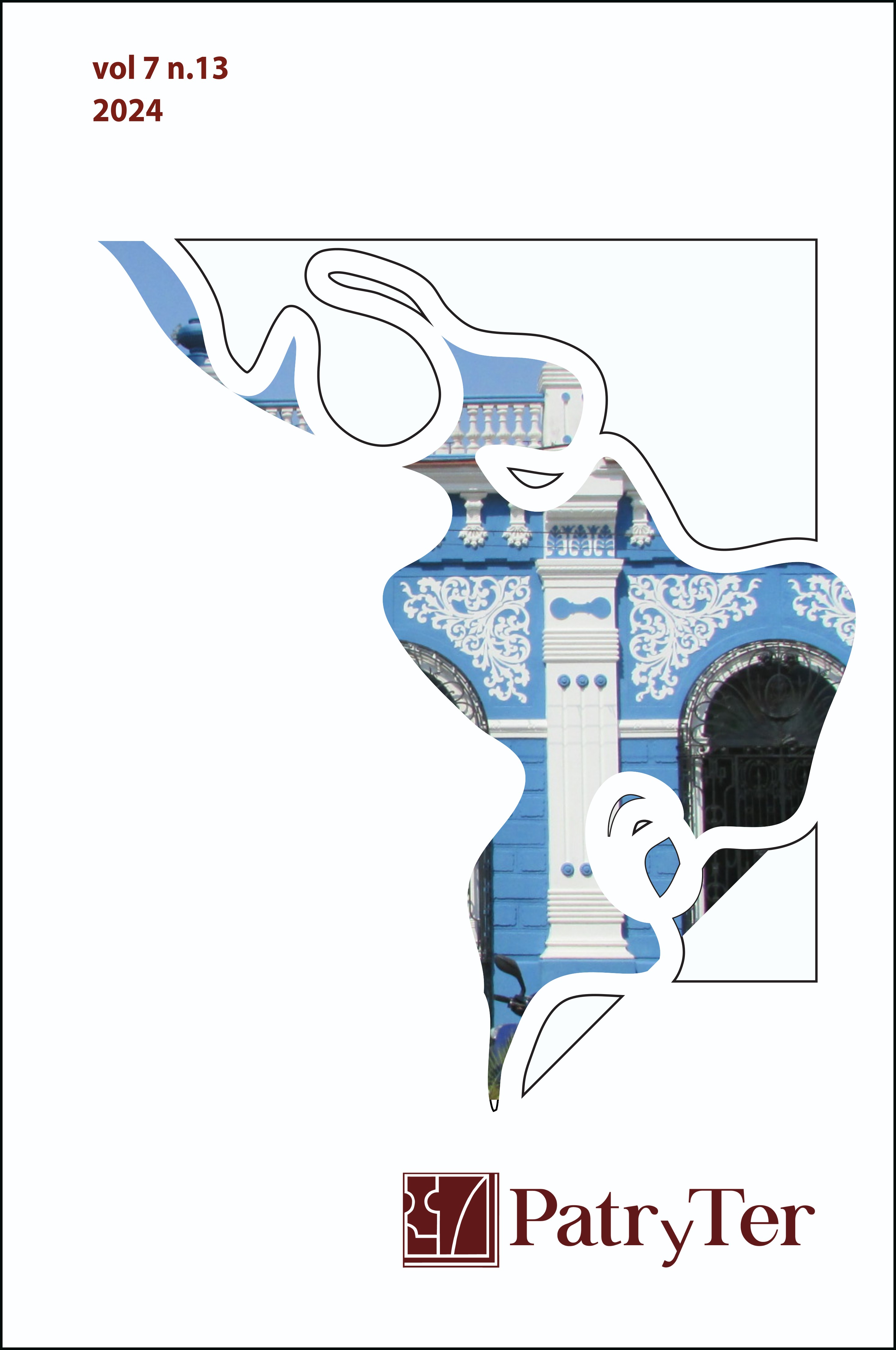The Three Kings Day Festival as a spatial resistance of the caipira culture (Juquitiba-SP)
DOI:
https://doi.org/10.26512/patryter.v7i13.42826Keywords:
territorialities. rural neighborhood. popular Catholicism.Abstract
The Three Kings Day Festival, a manifestation of caipira culture and popular Catholicism, is held annually in the municipality of Juquitiba-SP in the rural district of Camargos. Based on the concepts of territory and territoriality, we seek to understand and ponder on the permanence of the elements of caipira culture, such as the Three Kings Day Festival in the face of the increasing urbanization process. The field research for the registration of oral reports from its inhabitants, as well as the obtaining of other information during the festivities, was fundamental for this research. It is possible to consider, with the investigation, that although the urban expansion has affected the traditional ways of life, the different space appropriations are reflected in the formation of symbolic territories that sustain caipira culture practices, such as the Three Kings Day Festival, which gives it the character of resistance.
Downloads
References
Bosi, A. (1987). Cultura como tradição. In G. Bornheim., A. Bosi, J. Pessanha, R. Schwarz, S. Santiago & P. Duarte (Ed.). Cultura brasileira: tradição/contradição (pp. 112-137). Rio de Janeiro: Jorge Zahar.
Brandão, C. (1977). A Folia de Reis de Mossâmedes. Cadernos de Folclore (20). Rio de Janeiro: Arte-FUNARTE, Campanha de Defesa do Folclore Brasileiro.
Brandão, C. (1981). Sacerdotes de viola: rituais religiosos do catolicismo popular em São Paulo e Minas Gerais. Petrópolis: Vozes.
Brandão, C. (1983). Os caipiras de São Paulo. São Paulo: Editora Brasiliense.
Brandão, C. (2010). Prece e folia: festa e romaria. Aparecida: Ideias & Letras.
Canclini, N. (1983). As culturas populares no capitalismo. São Paulo: Brasiliense.
Castro, Z. & Couto, A. (1977). Folias de Reis. Cadernos de Folclore (16). Rio de Janeiro: Arte-FUNARTE, Campanha de Defesa do Folclore Brasileiro.
Candido, A. (2010). Os parceiros do Rio Bonito: estudo sobre o caipira paulista e a transformação dos seus meios de vida (11a ed.). Rio de Janeiro: Ouro sobre azul.
Claval, P. (1999). O território na transição da pós-modernidade. GEOgraphia, 1(2). 7-26. https://doi.org/10.22409/GEOgraphia1999.v1i2.a13349
Corrêa, D. (1999). O aldeamento de Itapecerica da Serra: de fins do século XVII a 1828. São Paulo: Estação Liberdade.
Fukui, L. (1979). Sertão e Bairro rural. São Paulo: Ática.
Haesbaert, R. (2014). Viver no limite. Rio de Janeiro: Bertrand Brasil.
Instituto Brasileiro de Geografia e Estatísticas. (2010). Censo Demográfico 2010. https://cidades.ibge.gov.br/brasil/sp/juquitiba/pesquisa/23/22957?detalhes=true
Instituto Brasileiro de Geografia e Estatísticas. (2017). Classificação e caracterização dos espaços rurais e urbanos do Brasil: uma primeira aproximação. Rio de Janeiro: Coordenação de Geografia. https://www.ibge.gov.br/geociencias/organizacao-do-territorio/tipologias-do-territorio/15790-classificacao-e-caracterizacao-dos-espacos-rurais-e-urbanos-do-brasil.html?=&t=acesso-ao-produto
Lei n. 601, de 18 de setembro de 1850. (1850). Dispõe sobre as terras devolutas do Império. Presidência da República. https://www.planalto.gov.br/ccivil_03/leis/lim/lim601.htm
Lefebvre, H. (1978). De lo rural a lo urbano. Barcelona: Ediciones península.
Lefebvre, H. (2013). La Producción del espacio. Madrid: Capitán Swing Libros.
Mauss, M. (2003). Sociologia e antropologia. São Paulo: Cosac e Naify.
Muller, N. (1951). Sítios e Sitiantes no Estado de São Paulo. Boletim da Faculdade de Filosofia, Ciências e Letras da Universidade de São Paulo, 132(7). São Paulo: FFCL.
Petrone, P. (1995). Aldeamentos paulistas. São Paulo: Editora da Universidade de São Paulo.
Priore, M. (1994). Festas e Utopias no Brasil Colonial. São Paulo: Editora Brasiliense.
Queiroz, M. (1968). Sociologia - O Catolicismo Rústico no Brasil. Revista do Instituto de Estudos Brasileiros, (5),104-123. https://www.revistas.usp.br/rieb/article/view/45715
Queiroz, M. (1973). Bairros rurais paulistas: dinâmicas das relações bairro rural – cidade. São Paulo: Livraria Duas Cidades.
Queiroz, M. (1991). Variações sobre a técnica de gravador no registro da informação viva. São Paulo: T. A. Queiroz.
Downloads
Published
How to Cite
Issue
Section
License
Copyright (c) 2024 PatryTer

This work is licensed under a Creative Commons Attribution-NonCommercial-NoDerivatives 4.0 International License.
Please be advised that Revista Patryter is licensed under a Creative Commons Attribution-NonCommercial-NoDerivatives 4.0 International License (CC BY-NC-ND 4.0) https://creativecommons.
Authors who publish in the PatryTer Magazine agree to the following terms:
- Authors retain the copyright and grant the journal the right of first publication, the work being simultaneously licensed under the Creative Commons Attribution License which allows the sharing of the work with recognition of the authorship of the work and initial publication in this journal.
- The contribution is original and unpublished and is not being evaluated for publication by another journal. When submitting the article, authors should attach as a supplementary document a Letter addressed to the PatryTer's Editor, indicating the academic merits of the submitted work (relevance, originality and origin of the article, that is, from what type of research]. This letter must be signed by all authors.
- Authors assign the copyright of the work that they present to the Editorial Board of PatryTer Magazine, which may serve the article in the PatryTer Magazine and in public and private databases in Brazil and abroad.
- Authors declare that they are fully responsible for the entire contents of the contribution that they submit to the Editorial Board of PatryTer Magazine.
- Authors declare that there is no conflict of interest that could interfere in the impartiality of the scientific papers submitted to the PatryTer Magazine Editorial Board.
- Authors are authorized to take additional contracts separately, for non-exclusive distribution of the version of the work published in this journal (eg publish in institutional repository or as a book chapter), with acknowledgment of authorship and initial publication in this journal.
Authors are allowed and encouraged to publish and distribute their work online (eg in institutional repositories or on their personal page) at any point before or during the editorial process, as this can generate productive changes as well as increase the impact and the citation of the published work (See The Effect of Free Access).




